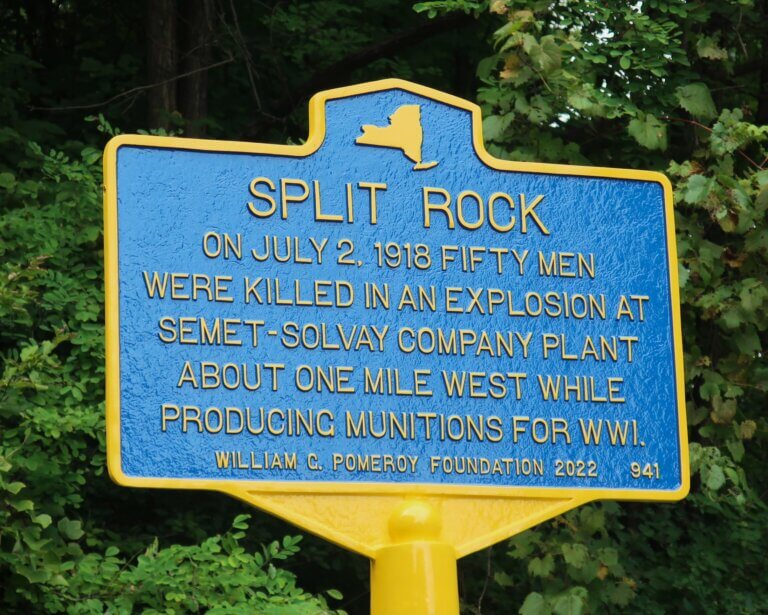SPLIT ROCK
- Program
- Subject
- Location
- Lat/Long
- Grant Recipient
-
NYS Historic
-
Event, Industry & Commerce, Site
- 5348 Onondaga Rd, Camillus, NY 13031, USA
- 43.030389193578, -76.227509225627
-
Town of Onondaga Historical Society
SPLIT ROCK
Inscription
SPLIT ROCKON JULY 2, 1918 FIFTY MEN
WERE KILLED IN AN EXPLOSION AT
SEMET-SOLVAY COMPANY PLANT
ABOUT ONE MILE WEST WHILE
PRODUCING MUNITIONS FOR WWI.
WILLIAM G. POMEROY FOUNDATION 2022
On July 2nd, 1918 an explosion at the Semet-Solvay Company plant in Split Rock, New York killed fifty men. Originally a limestone quarry, the Semet-Solvay Company plant built a factory and began producing munitions on the site during World War I to meet the increased demand for TNT throughout the War. The tragedy struck at around 8:30 pm when a fire started at the TNT plant no. 1, which soon led to an explosion when the flames spread to the picric plant. The blast occurred after the plant lost power leaving those fighting the blaze in near darkness in the moments leading up, and many of the fireman and patrolmen on site were reported to have been thrown several feet. The explosion was enormous and felt for miles, and took until the next day to completely extinguish the flames. Still, a much larger tragedy was prevented: as the fire spread it threatened the bunkers of Canada Hill, which stored an estimated 1.5 million pounds of explosives. A change in the wind prevented the storage bunkers from catching fire, nearly avoiding a much larger explosion.
Although initial newspaper reports following the tragedy varied widely regarding the total number of workers who lost their lives in the initial blast, on July 30th 1918 nearly a month after the accident the Syracuse Herald wrote:
“The death toll of the Split Rock explosion on the evening of July 2d was fifty. This fact appears to have been determined beyond a reasonable doubt. Thirty-three bodies had been already identified. There are seventeen still left in the morgue… there seems no longer any doubt that the coroner has accounted for all the bodies brought to the morgue, and that all the bodies of men who lost their lives in the fire and explosion were brought to the morgue.”
The Semet-Solvay company had provided the coroner with the names of those still missing, which aligned with the fifteen unidentified bodies at the morgue. The tragedy at Split Rock occurred roughly five months before the armistice ending World War I was signed, after which the Split Rock plant closed. This marker, located approximately a mile west of the site of the tragedy, commemorates both the night of the accident and the fifty men who lost their lives in the explosion.

